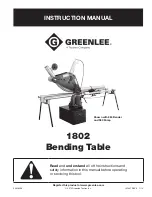
3
English
e )
Maintain power tools and accesories. Check
for misalignment or binding of moving parts,
breakage of parts and any other condition
that may affect the power tool’s operation. If
damaged, have the power tool repaired before
use.
Many accidents are caused by poorly maintained
power tools.
f )
Keep cutting tools sharp and clean.
Properly
maintained cutting tools with sharp cutting edges are
less likely to bind and are easier to control.
g )
Use the power tool, accessories and tool bits, etc.
in accordance with these instructions, taking
into account the working conditions and the
work to be performed.
Use of the power tool for
operations different from those intended could result
in a hazardous situation.
h )
Keep handles and grasping surfaces dry, clean
and free from oil and grease.
Slippery handles and
grasping surfaces do not allow for safe handling and
control of the tool in unexpected situations.
5) Service
a )
Have your power tool serviced by a qualified
repair person using only identical replacement
parts.
This will ensure that the safety of the
power tool is maintained.
•
Disconnect power before using tool near live wires or
where there may be hidden wiring.
Cutting accessory
contacting a “live” wire may make exposed metal parts
of the power tool “live” and could give the operator an
electric shock.” Always check for hidden wiring, gas lines,
or other utilities before performing any material cutting or
removal operations with the tool.
•
Wait for the cutter to stop before setting the tool
down.
An exposed cutter may engage the surface leading
to possible loss of control and serious injury.
•
Do not operate this tool for long periods of time.
Vibration caused by the operating action of this tool may
cause permanent injury to fingers, hands, and arms. Use
gloves to provide extra cushion, take frequent rest periods,
and limit daily time of use.
•
Do not restart the cutting operation in the work
piece.
Let the tool reach full speed and carefully re-enter
the cut.
•
Do not “jam” the saw blade or apply excessive
pressure.
Do not attempt to make an excessive depth
of cut.
•
Keep your hands away from cutting area.
Do not
reach under the material being cut.
•
Do not use dull or damaged blades.
Bent blade
can break easily or cause kickback. Exercise extreme
caution when handling the accessories. The accessories
are very sharp. Wear protective gloves when changing
cutting accessories. Accessories become hot after
prolonged usage.
•
Before scraping, check work piece for nails.
If there
are nails, either remove them or set them well below
intended finished surface. Striking a nail with accessory
edge could cause the tool to jump.
•
Do not wet sand with this tool.
Liquids entering the
motor housing are an electrical shock hazard.
•
Never work in area which is soaked with a liquid,
such as a solvent or water, or dampened such as
newly applied wallpaper.
There is an electrical shock
hazard when working in such conditions with a power
tool and heating of the liquid caused by scraping action
may cause harmful vapors to be emitted from work piece.
•
Do not use sandpaper intended for larger sanding
pads.
Larger sandpaper will extend beyond the sanding
pad causing snagging, tearing of the paper or kick-back.
Extra paper extending beyond the sanding pad can also
cause serious lacerations.
Additional Safety Rules for Oscillating
Multi-Tools
•
Hold power tool by insulated gripping surfaces,
when performing an operation where the cutting
accessory may contact hidden wiring or its own
cord.
Cutting accessory contacting a “live” wire may make
exposed metal parts of the power tool “live” and could give
the operator an electric shock.
•
Use clamps or another practical way to secure and
support the work piece to a stable platform.
Holding
the work by hand or against your body leaves it unstable
and may lead to loss of control.
•
Air vents often cover moving parts and should be
avoided.
Loose clothes, jewelry or long hair can be
caught in moving parts.
Specific Safety Warnings and
Instructions: Sanders
Sanding Lead Based Paint
Sanding of lead based paint is NOT RECOMMENDED due
to the difficulty of controlling the contaminated dust.
The greatest danger of lead poisoning is to children and
pregnant women.
Since it is difficult to identify whether or not a paint contains
lead without a chemical analysis, we recommend the
following precautions when sanding any paint:
Personal safety
• No children or pregnant women should enter the work
area where the paint sanding is being done until all
clean up is completed.
• A dust mask or respirator should be worn by all persons
entering the work area. The filter should be replaced
daily or whenever the wearer has difficulty breathing.
nOTE:
Only those dust masks suitable for working with lead
paint dust and fumes should be used. Ordinary painting
masks do not offer this protection. See your local hardware
dealer for the proper (NIOSH approved) mask.
Содержание CMEW400
Страница 33: ......
Страница 34: ......
Страница 35: ......
Страница 36: ...CRAFTSMAN 701 East Joppa Road Towson MD 21286 Copyright 2018 03 18 Part No N550999 ...






































